Anti SUV campaigns have today written to organisers of the Wimbledon tennis championship calling for them to scrap the competition’s deal with Range Rover and encourage players to use ‘London’s world-renowned public transport network’.
The SUV Alliance, with the backing of ‘London parents and 15 grassroots groups’, says the summer sporting event should immediately terminate its 10-year partnership with the British car firm.
The open letter also demands the All England Lawn Tennis Club (AELTC) revokes the use of Range Rover hybrid vehicles for tournament participants and coaches over the ‘huge danger that supersized SUVs cause for children, pedestrians and cyclists’.
The group – in a separate statement – linked its concerns to the death of two eight-year old-girls, Selena Lau and Nuria Sajjad, who were killed outside their primary school in July 2023 – just streets away from where the Championships were taking place at the time.
Claire Freemantle, 48, crashed her Land Rover Defender into a crowd gathered for an end-of-term tea party at the nearby The Study Preparatory School, costing the lives of the two children and injuring 10 others.
Medical examination had originally shown that she had suffered an epileptic seizure, resulting in the loss of control of the £80,000 vehicle and was not charged. However, Freemantle was rearrested in January on suspicion of causing death by dangerous driving, with a full investigation ongoing.
JLR (formerly Jaguar Land Rover and the parent group of Range Rover) deferred comment on the letter to the AELTC, which said the SUVs are typically driven only in electric mode and that it requires players to travel with at least three guests, with large vehicles needed to transport their ‘considerable luggage, kit bags, equipment, and racquets’.
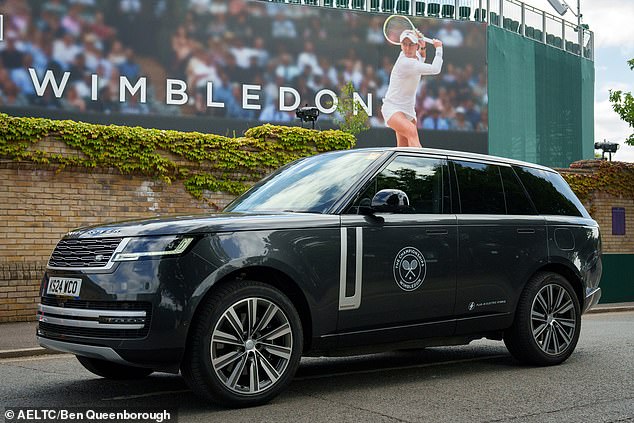
Anti SUV campaigns have today written to organisers of the Wimbledon tennis championship calling for them to scrap the competition’s deal with Range Rover and encourage players to use ‘London’s world-renowned public transport network’
In the open letter addressed to the chair of the AELTC, Ms Deborah Jevans CBE, and Usama Al-Qassab, its marketing and commercial director, the campaign group said: ‘We the undersigned are once again writing with dismay about the use of large SUVs as the official vehicle of the Wimbledon Championship, and the wider sponsorship of Wimbledon by Jaguar Land Rover as a leading manufacturer of these vehicles.
‘Research has shown that heavy and large SUVs, like the Range Rover, are especially dangerous to children and people walking, wheeling and cycling.
‘The use of these vehicles stands in direct contradiction to the sport-positive message of the Championship and ignores the concerns of Londoners.’
It referenced a recent YouGov poll of 1,000 London adults (conducted between 5 and 7 April 2025) that found that 61 per cent of parents in the capital are concerned that bigger cars make it more dangerous for children to walk and cycle.
‘The probability of someone walking or cycling being killed increases by 44 per cent when struck by an SUV compared to a small car, increasing further to 82 per cent for children. This is due to the extra weight of an SUV and design features such as a taller bonnet,’ the letter goes on.
‘Many of us are parents and grandparents ourselves and feel the dilemma of wanting to encourage our children to walk, wheel, cycle and play outdoors – for health, mental health and their own autonomy – but at the same time fearing what could happen if our children share the streets with supersized SUVs.’
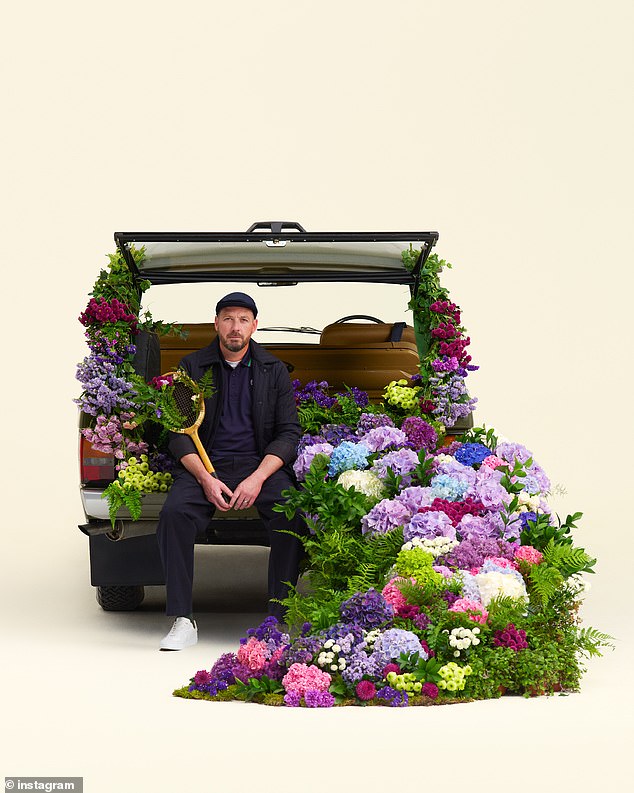
JLR has been an official partner for Wimbledon since 2015 and supplies a fleet of plug-in hybrid vehicles to transport players during the tournament
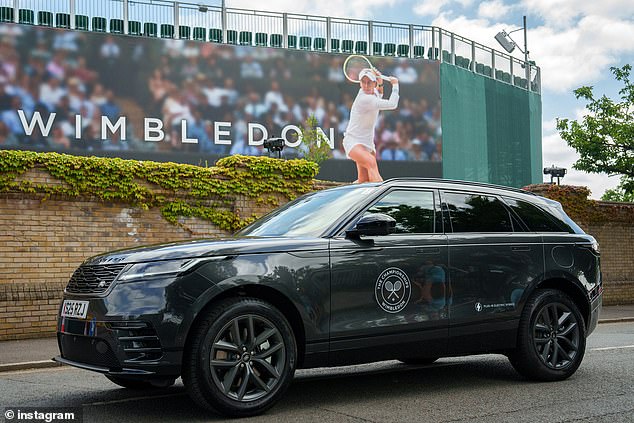
Organisers last year said the plug-in electric hybrid Range Rover, Range Rover Sport and Range Rover Velar (pictured) vehicles used are charged at the club ‘using 100 per cent renewable electricity for near-silent running throughout The Championships’
The letter also raised issue with the local air pollution impact of AELTC using Range Rover Plug-in Hybrid (PHEV) cars – which can be driven for around 75 miles in electric-only mode if the battery is fully charged – to transport players, their entourages and VIPs to and from the event.
Organisers last year said the plug-in electric hybrid Range Rover, Range Rover Sport and Range Rover Velar vehicles used are charged at the club ‘using 100 per cent renewable electricity for near-silent running throughout The Championships’.
However, the anti-SUV group said the vehicles will ‘still emit particulate pollution from tyre wear, a leading source of pollution in London, which is made more severe by the Range Rover’s weight’.
The letter carries on: ‘We must also be clear that this sponsorship is a form of advertising. The endorsement of large SUVs through partnerships like JLR and the AELTC drives an unnecessary aspirational culture for ever larger vehicles, at the expense of public space and safety for others.
‘Excessive advertising and marketing has contributed to SUV ownership surging in the UK, from just 19 per cent of sales 10 years ago to 62 per cent of new car sales last year.’
Instead of using Range Rover’s supplied fleet of PHEV models, the campaign group suggested organisers make its ‘large volumes of players and entourages around the tournament’ instead use ‘London’s world-renowned public transport network’ and ‘shared transport and active travel options’ to ‘set an example and to deliver the Championship’s fundamental sporting message’.
It adds that ‘where cars are necessary’ the organisers should only supply small electric vehicles while considering alternative vehicle partners.
In a further statement, Oliver Lord, head of the Clean Cities campaign group – which is part of the SUV Alliance – said: ‘It’s astonishing how Wimbledon insists on deploying large SUVs in our crowded capital despite excellent public transport and mounting evidence of the dangerous risk they pose to children.
‘Why can’t guests use public transport like most Londoners, at the very least, more normal sized cars that don’t crowd us off the roads or endanger people walking and cycling?’
JLR was contacted by This is Money, with a spokesperson telling us that it ‘defers to the All England Lawn Tennis Club for comment’.
This is Money has also contacted the AELTC for response.

The All England Club says it uses larger vehicles because it needs to transport players, their teams and ‘considerable luggage, kit bags, equipment, and racquets’ during the competition
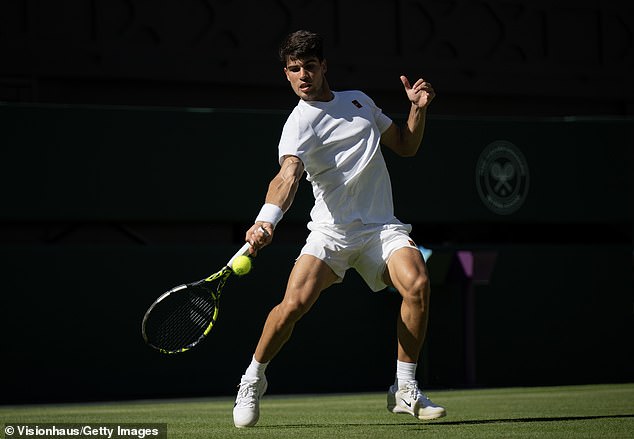
The 2025 Wimbledon tournament started on Monday, with the anti-SUV campaigners issuing their open letter on Wednesday. Pictured: Defending Men’s Champion Carlos Alcaraz on Monday
A spokesperson for the All England Club commented: ‘JLR has been an important partner to The Championships since 2015, specifically with Range Rover this year.
‘We have worked closely with them on the inclusion of a significant number of lower emission plug-in hybrid vehicles in our fleet which, are being charged on-site with 100 per cent renewable electricity.
‘Given the length of Grand Slam events – three weeks from the start of practice to the conclusion of the competition – players generally prefer to stay in residential rather than hotel accommodation during their time at Wimbledon.
‘This is a great boost for the local area as players become part of the local community, but it does require a vehicle fleet to shuttle players between their accommodation and the grounds.’
The spokesperson added: ‘Players regularly travel with at least three guests, (typically coach, physio, or family members) and often arrive directly from other tournaments without going home for weeks or even months.
‘We work closely with these elite athletes and their teams to guarantee appropriate space, including head room for them and their entourage, who also often have considerable luggage, kit bags, equipment, and racquets.
‘Our objective is therefore to accommodate each player and their team within one vehicle versus the need for two separate vehicles.
‘Our focus this year remains for as many journeys as possible to be delivered in EV mode. Trip distances all take place within a seven-mile radius, but the average trip length is less than five miles, meaning the majority can be delivered on the EV range of the hybrid Range Rover vehicles which we are using.’
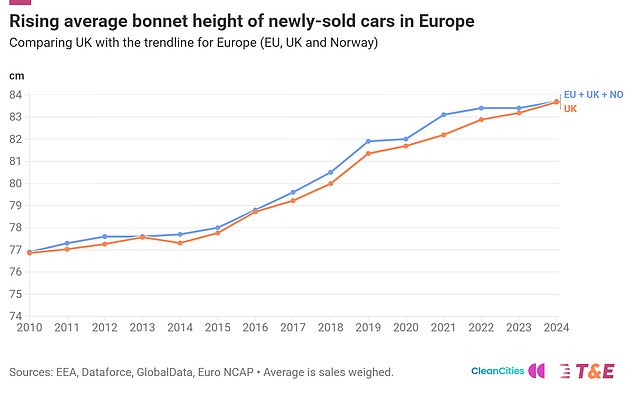
T&E’s analysis of the new car market found that the average bonnet height of a passenger car sold in the UK has jumped from 77cm in 2010 to 84cm in 2024
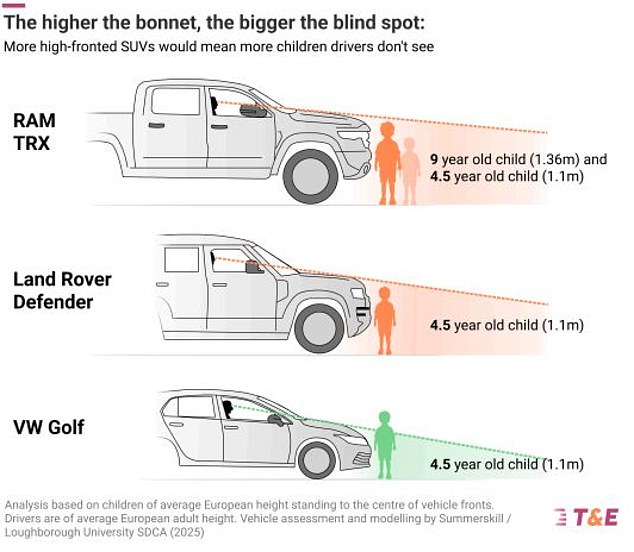
Analysis carried out by Loughborough University on behalf of T&E said a driver of a RAM TRX truck is unable to see a child up to 9 years old directly in front of their bumper. For a driver of a Land Rover Defender, the high bonnet blocks their view of children up to 4.5 years, it claimed

The report says higher-fronted SUVs significantly increases the death rate when pedestrians are struck as they are more likely to be pulled under a moving vehicle rather than bounce off them
The alliance’s attack on Range Rover comes weeks after an environmental think tank dubbed SUVs a ‘growing threat to public safety’.
It claimed their higher bonnets means drivers are unable to see children as old as nine standing directly in front of them. This, it said, is a particular risk when motorists are leaving a driveway or parking space, or when travelling in stop-start traffic outside schools.
Transport & Environment, which produced the report, said average bonnet heights for newly-sold cars in the UK is increasing by half a centimetre a year – reaching 83.8cm in 2024 – due to the ongoing popularity of SUV-style vehicles. It pointed the finger squarely at the demand for JLR models in Britain for accelerating this increase in bonnet height.
It claimed that the front of SUVs typically strike adult pedestrians above the centre of gravity, often first hitting vital organs in the body’s core, with a higher likelihood of knocking them forward and down, and a greater risk of driving over them.
This is deemed far more dangerous than conventional hatchback and saloon cars with lower bonnets, which tend to hit pedestrians’ legs, giving them greater chances of falling towards the vehicle, or of being deflected.
However, JLR (formerly Jaguar Land Rover and the parent company of Range Rover) hit back at that report, saying it fits all its new models with the ‘latest in advanced safety technology features’ to mitigate such scenarios. This includes pedestrian detection, 3D surround cameras, and autonomous emergency braking.
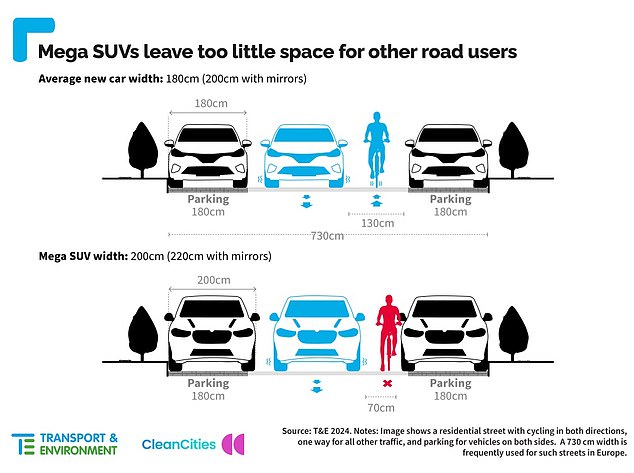
Transport & Environment previously accused supersized SUVs – like the Range Rover – of leaving less room for other road users as well as being too big for standard parking bays
Claire Freemantle, the driver of the Land Rover Defender that collided with and caused the death of the two school girls on 6 July 2023, was originally arrested at the scene.
Following an initial investigation, the Crime Prosecution Service (CPS) said Ms Freemantle had suffered an epileptic seizure behind the wheel, which caused her to lose control of the vehicle that then drove through a fence and into the school playground.
As a result this meant she would not be charged, it said.
At the time, her solicitor said her epilepsy had ‘never previously manifested itself’ and Ms Freemantle ‘had always enjoyed good health’.
However, in January, Freemantle was released on bail after being rearrested earlier that month on suspicion of causing death by dangerous driving.
She was arrested for the second time after the Met Police said it reviewed its investigation following the CPS’s decision last June not to charge her.
The Met Police said a specialist crime review group had ‘identified lines of inquiry which required further examination’.
Speaking in response to the tragic incident, a JLR spokesperson today told This is Money: ‘Our deepest sympathies remain with all those affected.
‘The Police investigation is still ongoing and therefore it would be inappropriate for us to provide further comment.’













